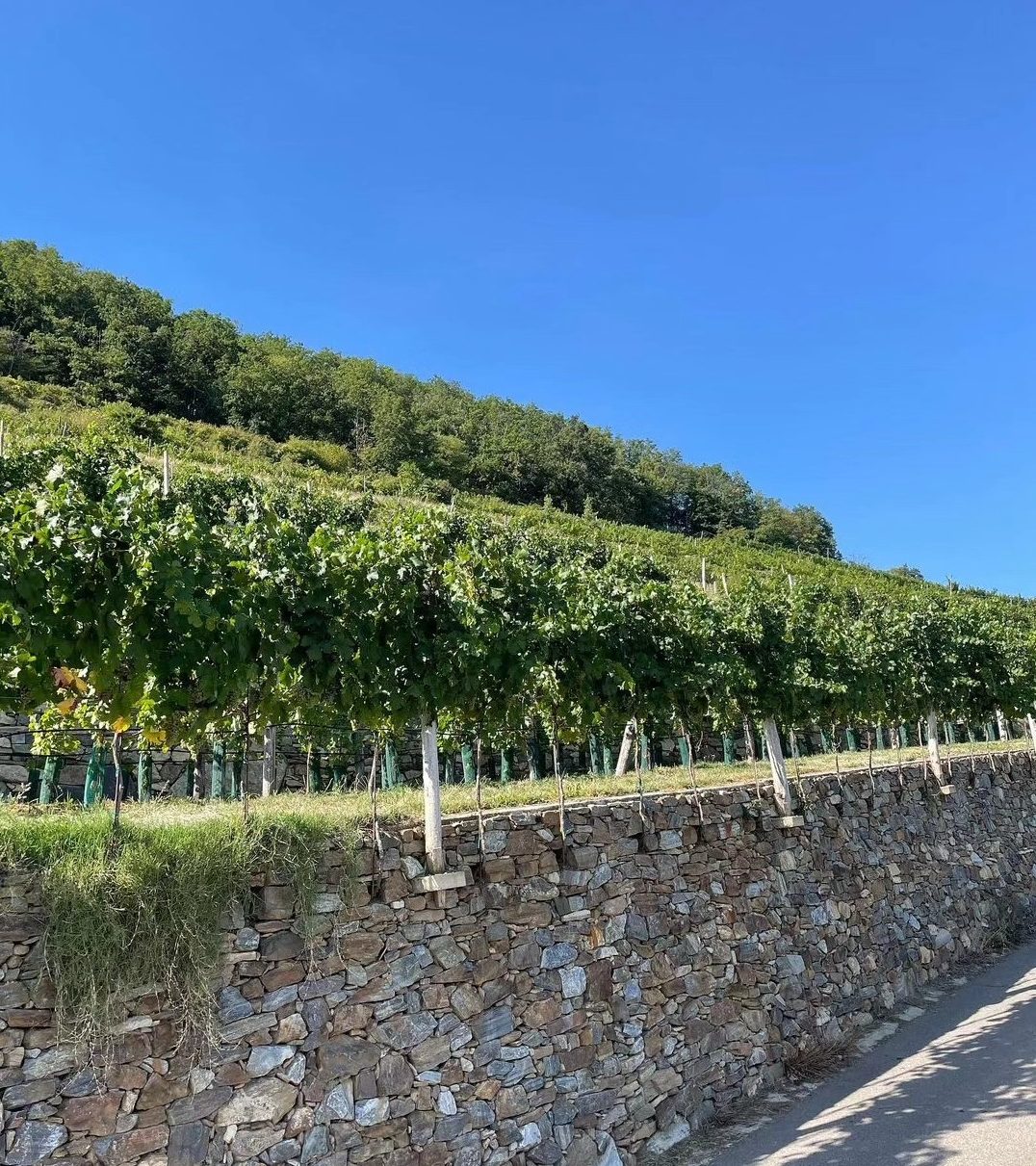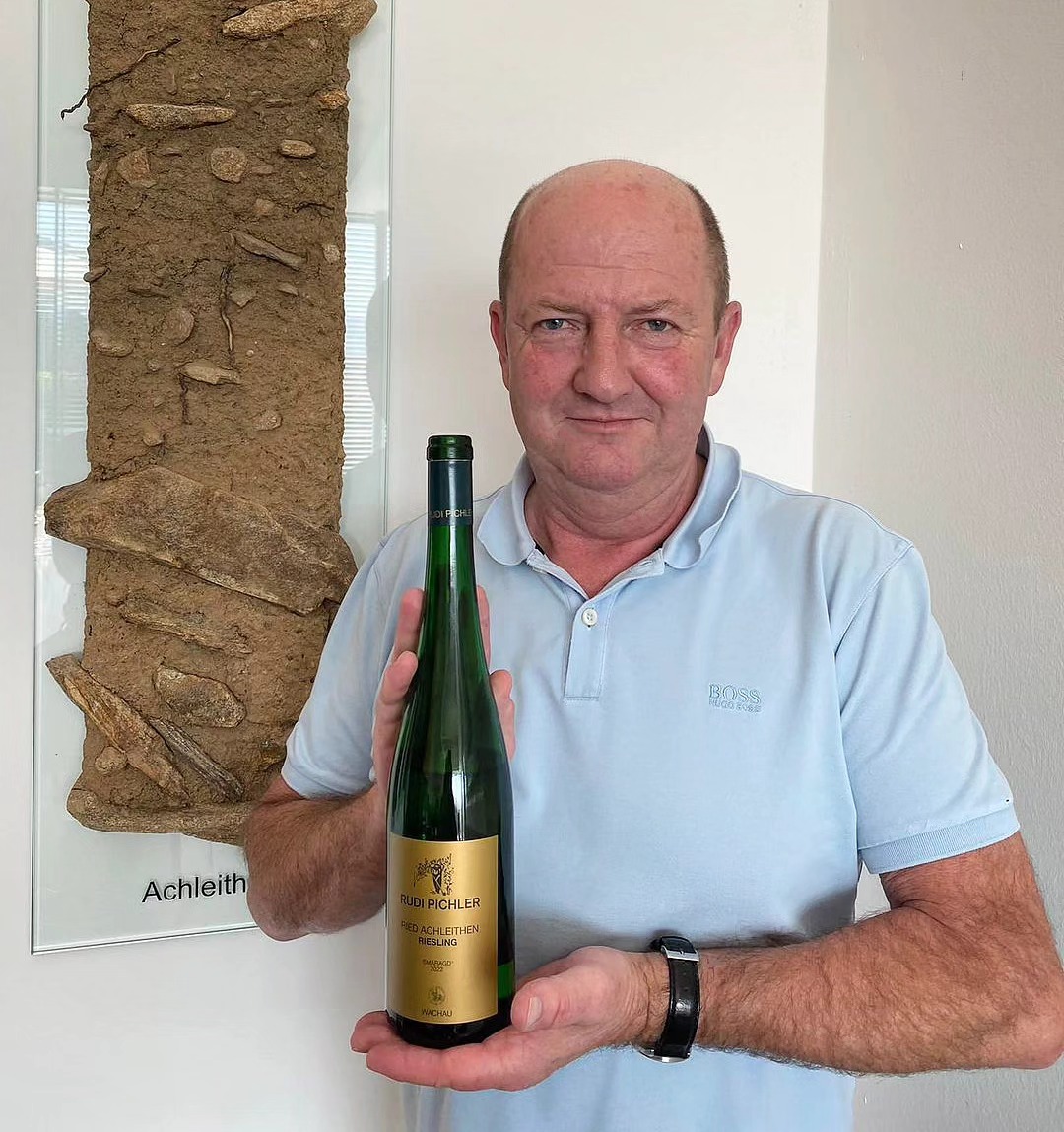
Senior Editor Stuart Pigott and Associate Editor Claire Nesbitt arrived in Austria 10 days ago with the prime mission of assessing the dry white wines from the recently bottled 2022 vintage, but it was two late releases they tasted from the 2021 vintage that were the real standouts.
The F.X. Pichler Riesling Wachau Unendlich 2021 and F.X. Pichler Grüner Veltliner Wachau Unendlich 2021 are a pair of enormously concentrated but impeccably balanced wines that exemplify all the qualities that make Austrian dry white wines special. Stuart said encountering the perfect acidity of the Unendlich made him feel as though he had been beamed to the far side of the moon, and the gruner veltliner was totally tropical with a stunning chalky minerality.
Unendlich means “infinite” in German, which might sound pretentious, but it gives a good idea of what these wines taste like. These are not single-vineyard bottlings but blends of the ripest grapes from Lucas and Johanna Pichler’s top vineyard sites. Both were fermented and matured in 500-liter oak casks, some of which were new for the gruner veltliner and none of which were well used for the riesling. The astonishing label features a 200-year-old set design by the German architect Karl Friedrich Schinkel for the Queen of the Night aria in Mozart’s opera The Magic Flute.

F.X. Pichler was also one of a string of Austrian wine producers who managed to produce remarkable wines in the 2022 vintage, as you will see when you read the notes below. That was more challenging than in 2021 due to the way the hot and dry early summer was followed by heavy rains in August.
In the age of climate change, there is a widespread global tendency to dismiss less successful vintages for being too low in acidity for the wines to balance well, and that story has been told about 2022 in Austria. However, the 2022 Austrian dry whites have a very pronounced acidity. When the wines were on the weak side it often stuck out, but when the wines had enough ripeness and depth there was wonderful brilliance. The aromatics of less successful 2022s can be quite simple and monotonously citric. This problem is clearly more common among the gruner veltliners, particularly those from vineyards in the Kamptal, Kremstal and Wagram regions with loess soils. Loess is a water-retentive and nutrient-rich soil that soaked up the heavy rains in August.
The Franz Hirtzberger Riesling Wachau Ried Singerriedel Smaragd 2022 is a really great example of a wine marrying the whiplash acidity of the vintage with mandarin orange, mango and persimmon fruit. It is extremely complex. “We had to select the grapes very rigorously for our top wines in 2022 but it was worth all the effort,” Franzi Hirtzberger explained.
Stuart actually preferred Hirtzberger’s 2022 Ried Singerriedel riesling to the same single-vineyard wine from 2021; a rare instance of the latest vintage topping its great predecessor.


Claire and Stuart also spent a few days at the annual Single Vineyard Summit of the OTW (Osterreichische Traditionsweinguter, an association of winegrowers in the Danube region), tasting many of the latest releases of OTW Erste Lage (premier cru) wines. It is a particularly exciting time for winegrowers in the Danube region as Erste Lage has this year entered into Austrian law. The application process for single vineyards will take time and the first designated single vineyards are expected from the 2025 vintage.
Some of the top wines at the summit were Hirsch’s single-vineyard rieslings from the Kamptal region as well as some gruner veltliners from the Wagram region. The Hirsch Riesling Kampal Heiligenstein-Rotfels EL 2022 was the clear star, though. Here, white peach fruit, floral honey character and crushed rock character are exactly matched. In spite of the overwhelming concentration, this is as crystalline as a white wine gets! The Heiligenstein-Rotfels is a sub-site of the legendary Heiligenstein vineyard site and Hirsch first vinified it as separate wine in the 2021 vintage. We predict that this is going to become a new cult wine, as sought after as F.X. Pichler’s dry riesling from the Ried Kellerberg!
Claire also singled out the Bernhard Ott Grüner Veltliner Wagram Ried Rosenberg EL 2021 for its aromatic complexity, ranging from savory herbs to yellow fruit, honey and minerals. Another top 2021 gruner veltliner is the Bründlmayer Grüner Veltliner Kamptal Ried Käferberg EL 2021. It is creamy and intense, with spicy and zesty elements and fantastic balance.


During their visits to the Wachau, Stuart and Claire tasted with Toni Bodenstein of Weingut Prager. Their rieslings and gruner veltliners both shined. The Prager Riesling Wachau Klaus Smaragd 2022 is a seamless, long and deep white, with tension and a cool minerality. It will reward a few more years in bottle. Just as impressive was the Prager Grüner Veltliner Wachau Zwerithaler Kammergut Smaragd 2022. Produced from just nine terraces of vines planted in 1907, it showed intense aromas and weighty layers of yellow and orange fruit.
Another spectacular entry from the Pichler family, meanwhile, was the Rudi Pichler Riesling Wachau Ried Achleithen Smaragd 2022. The very cool and youthful nose of this dry riesling masterpiece, from pulls you into a tunnel of wet stone minerality on the extremely precise palate. Here’s a top 2022 dry white from Austria that’s delicious now but has enormous aging potential.
Claire also met with top producers Alzinger and Josef Jamek in the villages of Durnstein and Joching, respectively. Alzinger’s 2022 smaragd rieslings impressed with their sharpness and tension. The Ried Loibenberg Smaragd 2022 is produced from vines grown high up on the hillside, which are shaded in the afternoon, resulting in a mineral and driven, even slightly austere wine. The Ried Steinertal Smaragd 2022 is likewise sharp and well structured, with a rocky minerality married with just-ripe stone fruit.

The standouts from Josef Jamek were both from the Klaus single vineyard. The Josef Jamek Riesling Wachau Ried Klaus Smaragd 2022 is layered and open, with a complex balance between ripe fruit and salty minerality, and Claire also retasted the Josef Jamek Riesling Wachau Ried Klaus Beerenauslese 2017, which is not a new release but is showing so beautifully that we had to mention it. It’s honeyed and luxurious, full of dried fruit and with impressive concentration. (Beerenauslese is a sweet wine category produced from hand-selected, late-harvested berries with noble rot.)
In the Kremstal region, meanwhile, impressive white wines we tasted included Nigl’s Grüner Veltliner Kremstal Ried Pellingen EL Privat 2022 and Riesling Kremstal Ried Hochäcker EL Privat 2022, both slender and refreshingly mineral. And hailing from the Traisental region just across the Danube river, one of the coolest appellations in lower Austria, Markus Huber makes very precise wines from vines that are biodynamically farmed (but not certified). We were most impressed by the Huber Riesling Traisental Ried Rothenbart EL 2022, a laser-sharp and fresh riesling showing fantastic tension.
Read Stuart and Claire’s notes below and you will see that while a good number of 2022 dry whites are impressive and a few are truly remarkable, there are a lot of wines that are good but unremarkable, plus some real disappointments that lack the aromatic appeal and elegance we expect from Austrian dry whites.
THE SPANISH CONUNDRUM
Buying great bottles of wine from Spain today can either be a difficult choice or not difficult at all. On the not-so-difficult side, we are simply spoiled for choice, with some of the country’s most drinkable and affordable wines pouring out of Bierzo, Ribeira Sacra, the Canary Islands and Gredos to the ever-more diverse regions of Rioja and Priorat, with more powerful yet equally quaffable offerings from appellations like Ribera del Duero and Toro.
The difficulty comes with the highly rated Spanish wines, which have been getting more and more expensive, and coupled with their often woefully small volume of production in the face of high demand, more costly still. Dominio de Es is one of the few names in this category, and wine buyers should take further notice this year because the quality of the 2021 vintage is astonishing, so be prepared for sticker shock.
When the French winemaker Bertrand Sourdais arrived in Ribera del Duero after extensive experience in Bordeaux, Chile, and Spain (with Alvaro Palacios in Priorat), he found success with pre-phylloxera vines near San Esteban de Gormaz, some 70 kilometers southwest of Soria in the more extreme, eastern part of Ribera del Duero.
As the co-founder and technical director of Dominio de Atauta, he realized how Ribera del Duero and its precious ancient vines can be interpreted so differently through the various soils, altitudes and exposures. With his wife, Olga Escudero, he established the project Dominio de ES (E stands for Escudero and S for Sourdais) in 2011, renting old, pre-phyllloxera vineyards and farming them biodynamically.
La Diva is just a 0.35-hectare plot of ungrafted ancient tempranillo vines, along with some albillo, on a terraced site with northeastern exposure. Soil here is pure sand over calcareous rock, giving an ethereal, almost pinot-like sensibility to the 600 to 700 bottles of wine produced.
The 2021 vintage of La Diva is the most refined and Burgundy-like wine among the three crus. The other two are La Mata and the more recent addition, Carravilla. La Mata comes from a 0.33-hectare plot of pre-phylloxera vines planted in 1904 with sandy, silty, calcareous clay in the soils, which might explain the tight-knit structure and fleshy, darker fruit of the wine. The Carravilla comes from a 0.27-hectare plot set at an altitude of 935 meters altitude. The calcareous soils helped deliver a 2021 that, senior editor Zekun Shuai believes, might fall somewhere between La Mata and La Diva, showing some fluidity before the tense, chalky and broad-shouldered tannins.

– Stuart Pigott, Claire Nesbitt and Zekun Shuai contributed reporting.
The list of wines below is comprised of bottles tasted and rated during the past week by James Suckling and the other tasters at JamesSuckling.com. They include many latest releases not yet available on the market, but which will be available soon. Some will be included in upcoming tasting reports.
Note: You can sort the wines below by country, vintage, score and alphabetically by winery name. You can also search for specific wines in the search bar.



